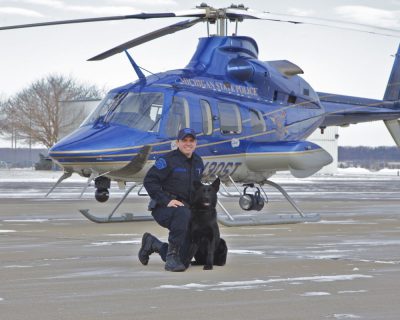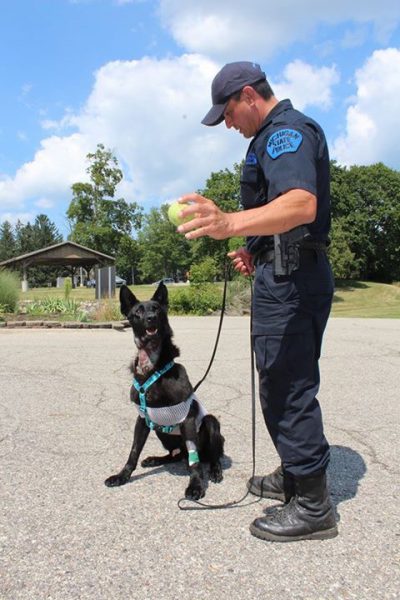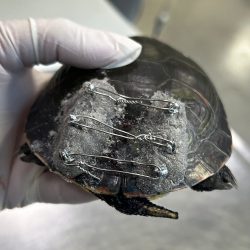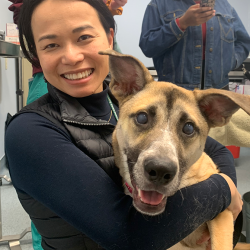
David Cardenas has been a trooper for Michigan State Police for nearly 19 years, the past 6 of which he has spent working with Bolt, a 7-year-old German Shepherd. Bolt helps Cardenas protect and serve the community in a number of ways. He can track missing people, chase criminals that flee from scenes, conduct building searches for people, find explosives, search properties for evidence, and apprehend uncooperative criminals. Bolt also is a tactical entry dog, which means he can work with an emergency support team when a subject has barricaded themselves in a building.
On one particular case, Cardenas and Bolt were attempting to track two suspects who fled from their vehicle after committing a drive-by shooting. The suspects crashed their car into the woods and took off on foot. Cardenas and Bolt arrived one hour after the crash and began their search. After searching for one mile, they located the suspects, who were hiding in the woods.
Cardenas told both suspects to show their hands. One suspect complied, but the other ran away. Cardenas sent Bolt into the woods, after the fleeing suspect.
“While pursuing the suspects, I was focused on locating them safely,” says Cardenas. “I thought once we found them, we would be done. Obviously, that wasn’t the case. But we had a good reactionary gap and cover. They were armed, so we were being very tactical. We were crashing through the woods in complete darkness, so it was hard to see.”
Cardenas watched and saw that as the suspect emerged from the trees and headed for the road, Bolt launched himself forward to apprehend him.
“That’s when I heard a yelp,” says Cardenas. “I assumed the suspect had punched Bolt.”

But Bolt continued to pursue the suspect. After crossing the roadway, Cardenas was able to deploy his Taser. The suspect fell to the ground on his stomach, but still would not show his hands. Cardenas activated the Taser again, and the suspect rolled over and threw an unknown object.
“That’s when Bolt grabbed the suspect’s foot and pulled his shoe off,” says Cardenas. “We took him into custody without further incident.”
After the suspect was secured, backup arrived. Another trooper found blood around the area where the suspect had been subdued. Cardenas checked himself and the suspect, but could find no visible injuries. He then sent Bolt to search for the item that the suspect had thrown. Within minutes, Bolt had tracked down a pocket knife with blood on it.
“That’s when I realized Bolt had been stabbed,” says Cardenas. Bolt, who is all black in color, showed no obvious signs of blood on his fur until Cardenas looked more closely. “It didn’t dawn on me as a possibility that Bolt had been stabbed until he found the knife because his behavior never changed,” Cardenas continues. “He continued to work and, besides the yelp, showed no signs of injury, even after the incident was over. I couldn’t believe he stabbed Bolt. I was overcome with anger at that point.”
Bolt was taken to the Animal Emergency Hospital of Rockford, Michigan, where he was assessed by Dr. Marilyn Brink and other veterinarians on staff. Bolt has a one-inch laceration on the right side of his neck, as well as swelling under his jaw. This swelling indicated a hematoma (bruise), which means that the wound was bleeding more inside Bolt’s body than could be seen on the outside. The emergency clinic cleaned and stapled Bolt’s wounds and referred him to MSU to have the wound explored and the cause of the bleeding addressed.
At the MSU Veterinary Medical Center, Bolt was seen by Dr. Tereza Stastny of the Emergency and Critical Care Service. His swelling had doubled in size, and significant bruising had developed. Concerned that Bolt may have suffered damage to other structures in his neck like the trachea or esophagus, MSU’s team performed cervical radiographs. These images showed swelling in Bolt’s soft tissues, along with some gas, which was likely let in through the stab wound.
MSU’s team sedated Bolt, cleaned the wound, and drained fluid from the swollen area. Fortunately, there was minimal bleeding. The next morning, Dr. David Upchurch of the Soft Tissue Surgery Service, performed a surgical exploratory procedure. He removed a large clot without any additional bleeding or damage to Bolt’s vital structures. The team cleaned Bolt’s wound again and placed a drain before closing the wound. This allowed fluid to drain through a tube placed into a canister on Bolt’s collar.
Bolt recovered while using pain medications and antibiotics. After two weeks, the incision had fully healed and his skin sutures were removed. Today, Bolt is back on the job.
“Bolt is doing great,” says Cardenas. “His injury healed very quickly, and you would never even know it happened.”
Bolt and Cardenas will be featured in the College’s upcoming public relations video, along with other members of the College community.



